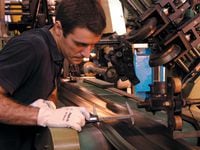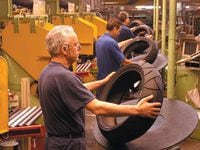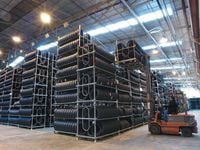FIRST, A CARTOON DRAWING of a tire appears, accompanied by a voice-over announcing, "A tire is round, and it is black...." Pfft--what a joke. I nudge the British journalist sitting next to me. "Wake me up for lunch," I tell him, but he's already asleep.
We're in a conference room at Michelin's tire factory in Lasarte, Spain, watching a PowerPoint presentation describing the company's tire-making process. Just as I prepare to get my snooze on, the voice-over for the second slide snaps me awake. "More than 200 different materials, both natural and synthetic, combine in the construction of a single tire: carbon black, silica, sulfur, plastics, vulcanizing agents, Kevlar cords...." Whoa, back the truck up. Where'd I put that notepad the Michelin folks gave us at the door? And hey, can I borrow your pencil?
Once a black art of heat-forming rubber and sand, modern tire construction is one of the most studied and scientific elements of motorcycle development. To drive this point home, the good folks at Michelin invited us to Lasarte and walked us step by step through the making of a tire. Michelin operates four tire-making facilities in Spain--Lasarte is the oldest (founded in 1934) and largest (covering more than 2 million square feet and employing 1461 people). It's also the most modern, frequently updated and ISO 9001 certified, and is ground zero for Michelin's high-performance motorcycle tire production. Everything short of one-off MotoGP and WSBK racing tires comes from Lasarte.
Michelin separates tire production into four stages: preparation, assembly, curing and quality control. Here's a detailed study of those stages, from raw material to final product.
PREPARATION
Tire design and engineering happens at Michelin's world headquarters in Clermont, France, not at the individual factories. Preparation for production at Lasarte begins in an upstairs office bank, where electronic schematics of the individual tires are created to guide the factory's computerized tooling. This electronic data is exceedingly important, as every step of tire production at Lasarte is computer tracked for quality-control purposes. Each individual tire produced by Michelin is assigned a computerized bar-code number that allows the company to trace the manufacture of that tire through each assembly step.
Similarly, the processing of raw materials takes place at other Michelin facilities before being shipped to Lasarte. Incoming rubber is marked according to quality, then dated--there is a three-week window between when raw rubber is processed and when it must be formed into a finished tire.
The tire-making process begins when "chunks" of rubber are combined and formed into the rolls (for flat-rolled products) and extrusions (for profiled products) that make the tread and other plies of the tire. Rolls and extrusions are formed in "endless" lengths, then cut into smaller pieces; a computer monitors this process at all times to insure that the right type of rubber is being used for the particular tire being made. Constant checks also control the weight and width of cut pieces.
Alongside the rubber-processing equipment are fabric-cutting units where various raw fabrics (polyester, nylon, Kevlar, Aramid, etc.) are similarly prepared. These cuttings, called laizes, are joined together to form the tire plies.
ASSEMBLY
Radial tire construction is a two-stage process: building the carcass, then applying the reinforcing plies and tread. Carcass assembly begins on a "tire drum,"--a rotating cylinder with a flexible center that allows the edges of the drum to be brought together. A thin, airtight sheet of synthetic rubber is first laid down on the drum, then topped with a casing ply containing parallel fabric cords for strength. The tire bead, a wire (or sometimes Kevlar) hoop, is put over the drum next, and the casing is folded over the bead wire. Once the bead is sealed, other compounds--well over a dozen, in most cases--are added. Tough, flexible sidewalls are laid down and the tire drum is "inflated" to give the carcass its shape. This completes the first stage.
Stage two begins with the addition of a strengthening cord (typically Kevlar or Aramid) to support the plies. This cord is laid crosswise to the casing plies to form shape-retaining triangles. Reinforcing tread plies are laid down on top of the cord, engineered to provide directional stability and mechanical resistance. This is the end of the second assembly stage; from here the "green" tire carcass will go to the curing mold, where it will be given its markings and tread pattern. A single person assembles a single tire, with the process taking anywhere from three to 10 minutes depending on the type of tire.
CURING
"Curing" refers to the chemical reaction (vulcanization) that transforms the tire from a plastic to elastic state and binds the rubber materials to the cords and other reinforcements. The green tire is inserted into a mold and formed using hot water and steam. Curing temperatures range from 150-190 degrees Fahrenheit, depending on the tire, and the process takes between nine to 15 minutes, depending on tire size and weight. Curing is a completely automated process.
QUALITY CONTROL
Tires are checked at every step to insure that various subassemblies conform to Michelin's exacting quality standards. The final quality check is a thorough inspection of the end product that combines a manual check by tire technicians with sophisticated simulation machinery.
The manual check happens as soon as the tire leaves the assembly line, and verifies the tire's aspect and appearance to insure compliance. After the manual check, the tire is tested on a road simulator that spins the tire up to road speed, then laser-checks performance with and without load to make sure the tire was properly constructed. A final bar code is applied after this simulation--if any problem is detected during quality control, the bar code is marked defective and the tire is destroyed.
There it is--round and black and so much more.
Ironically, as advanced as this tire-making process is, it might already be obsolete. Although Michelin reps are forbidden from discussing it at the present time, it's rumored that the company is close to perfecting its so-called "C3M" tire-making technology. C3M will allow Michelin to build tires virtually anywhere using equipment that fits into a semitrailer and requires nothing more than access to water and electricity.
Originally devised to allow the company to build tires on-site for auto manufacturers, Michelin recently began producing many of its MotoGP--and SBK-spec--tires using C3M technology because it allows tire engineers more control over the manufacturing process and results in a better tire. One Michelin rep says Valentino Rossi laps a half-second faster on a C3M-built tire compared with a tire made from the exact same materials using traditional tooling. As soon as C3M technology can be validated and made appropriate for large-scale production (possibly as soon as next year, an anonymous Michelin rep says), the techniques employed at Lasarte will be effectively obsolete, and production motorcycle tires will be even better.
Perhaps Michelin will have to invite us back to Spain next year to walk us through the mechanics of C3M. We'll make sure to bring our notebooks.















/cloudfront-us-east-1.images.arcpublishing.com/octane/IIGGWFOTOJGB7DB6DGBXCCMTDY.jpg)
/cloudfront-us-east-1.images.arcpublishing.com/octane/QSTCM6AVEZA5JJBUXNIQ3DSOF4.jpg)
/cloudfront-us-east-1.images.arcpublishing.com/octane/U4I7G625B5DMLF2DVIJDFZVV6M.jpg)
/cloudfront-us-east-1.images.arcpublishing.com/octane/B6XD6LS6IVCQPIU6HXDJSM3FHY.jpg)
/cloudfront-us-east-1.images.arcpublishing.com/octane/ICL63FEDDRDTTMINYICCEYGMDA.jpg)
/cloudfront-us-east-1.images.arcpublishing.com/octane/FCGZHQXRBZFLBAPC5SDIQLVF4I.jpg)
/cloudfront-us-east-1.images.arcpublishing.com/octane/WNOB6LDOIFFHJKPSVIWDYUGOPM.jpg)

/cloudfront-us-east-1.images.arcpublishing.com/octane/X33NU3E525ECRHXLNUJN2FTRKI.jpg)
/cloudfront-us-east-1.images.arcpublishing.com/octane/6KKT5NNL2JAVBOXMZYS5ZO76YA.jpg)
/cloudfront-us-east-1.images.arcpublishing.com/octane/J5RKG5O455GMPGQRF2OG6LRT7A.jpg)
/cloudfront-us-east-1.images.arcpublishing.com/octane/GX2CIZKQVRH2TATDM26KFG2DAE.jpg)
/cloudfront-us-east-1.images.arcpublishing.com/octane/ZWIDYSAKQZHD5BHREMQILXJCGM.jpg)
/cloudfront-us-east-1.images.arcpublishing.com/octane/CYUHJZCTSJCH3MRAQEIKXK7SCQ.jpg)
/cloudfront-us-east-1.images.arcpublishing.com/octane/LKOFINY56FCXJCANJ5M7ZDQUBY.jpg)
/cloudfront-us-east-1.images.arcpublishing.com/octane/4NBPDACMWJH63JQYJVK3QRBDZI.jpg)
/cloudfront-us-east-1.images.arcpublishing.com/octane/KKHQHRR3FJGX7H2IPU6RALMWG4.jpg)

/cloudfront-us-east-1.images.arcpublishing.com/octane/5IOFS5JAE5FOXMNA23ZRAVVYUU.jpg)
/cloudfront-us-east-1.images.arcpublishing.com/octane/CGXQ3O2VVJF7PGTYR3QICTLDLM.jpg)

/cloudfront-us-east-1.images.arcpublishing.com/octane/OQVCJOABCFC5NBEF2KIGRCV3XA.jpg)
/cloudfront-us-east-1.images.arcpublishing.com/octane/OPVQ7R4EFNCLRDPSQT4FBZCS2A.jpg)
/cloudfront-us-east-1.images.arcpublishing.com/octane/YBPFZBTAS5FJJBKOWC57QGEFDM.jpg)